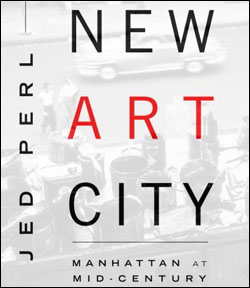Jed Perl’s New Art City is as knotty as it is ambitious. Stack your Hegel, Kant, Marx, and any and all NYC gallery guides on the nightstand: everything’s about to get real heavy.
The art critic for the New Republic, Perl has a simple premise: Manhattan in the ’30s to the ’50s was one of culture’s great artistic melting pots, a time and, more important, a place in which burgeoning styles of architecture, drama, and poetry created a febrile environment for the rise of what, along with jazz, may be America’s great indigenous art, the beast that is Abstract Expressionism. And what a many-headed monster this creature is: Action Painting, Joseph Cornell boxes, inter-faction rivalries, critical backlashes, pundits and poseurs, and work whose very abstractness can still provoke outrage.
 Perl writes in the tradition of æsthetic exposition once dominated by the likes of Clement Greenberg and Harold Rosenberg — big-time players in this story — and you get the feeling that even he doesn’t always know which back alley his narrative is about to go chasing down. There are heady philosophical overtones throughout — all of your various isms, not to mention Marx and Goethe. He glosses over Pop fairly quickly, putting the emphasis not just on Pollock, De Kooning, Jasper Johns, and Duchamp but on less widely recognized but nonetheless influential artists like Robert De Niro (senior, that is), Leland Bell, Claes Oldenburg, and Philip Guston.
Perl writes in the tradition of æsthetic exposition once dominated by the likes of Clement Greenberg and Harold Rosenberg — big-time players in this story — and you get the feeling that even he doesn’t always know which back alley his narrative is about to go chasing down. There are heady philosophical overtones throughout — all of your various isms, not to mention Marx and Goethe. He glosses over Pop fairly quickly, putting the emphasis not just on Pollock, De Kooning, Jasper Johns, and Duchamp but on less widely recognized but nonetheless influential artists like Robert De Niro (senior, that is), Leland Bell, Claes Oldenburg, and Philip Guston.
Perl is all over this stuff, carried away by stroke techniques and statements implicit in bits of canvas left unpainted. He describes Guston’s abstract work as “dreamy, almost evanescent, with no image to speak of,” work both reserved and daringly vulnerable, poised for a myriad of interpretations. This is a book of big statements. Perl begins his Manhattan-cum-utopia parable with Hans Hofmann and his school for fledgling artists, an introductory tale of a German expatriate come to New York, like so many disparate elements and people, to realize a new identity — in Hofmann’s case, that of disseminator and sage, a man who understood the dramatic pull and push of color, narrative, and movement in a painting, no matter how abstract. Frequently in New Art City, “abstraction” is a catch-all for non-objective art, for paintings and sculpture that may appear to rail against form but instead disassemble it to create purer forms, new modes of articulation, a redesigning of the zeitgeist. Perl also draws our attention to the forebears of such radicalism, the artists who “made it new” before modernism become bounded by all these catchphrases, the little-known 17th-century Le Nain brothers, and Monet and his vast water-lily canvases, form-busting works that we might think of as indulgent and naturalistic rather than as dreamscapes and meditations on perception, the internalized drama of the mind’s eye.
There is a New York–centric onanism to all of this: the city is billed as a place where “painters and sculptors could take the metaphysics of art history for granted and pour all of their energies into the specifics.” Of course, the idea that Art Deco radiance, street grids, subways, and Village coffeeshop talks are as responsible for Abstract Expressionism as the painters themselves, their ideas and their color narratives, is a contradiction of the movement’s free-ranging identity. But in having written himself into that same tradition, Perl skirts some of the limitations of his own argument, a moving — and impressive — dialectic in itself.